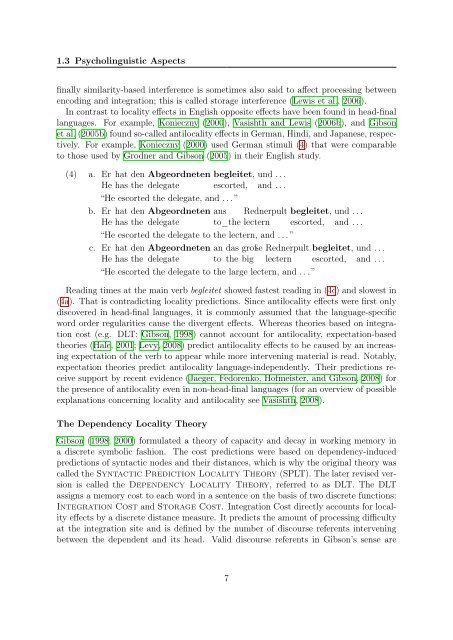Connectionist Modeling of Experience-based Effects in Sentence ...
Connectionist Modeling of Experience-based Effects in Sentence ...
Connectionist Modeling of Experience-based Effects in Sentence ...
Create successful ePaper yourself
Turn your PDF publications into a flip-book with our unique Google optimized e-Paper software.
1.3 Psychol<strong>in</strong>guistic Aspects<br />
f<strong>in</strong>ally similarity-<strong>based</strong> <strong>in</strong>terference is sometimes also said to affect process<strong>in</strong>g between<br />
encod<strong>in</strong>g and <strong>in</strong>tegration; this is called storage <strong>in</strong>terference (Lewis et al., 2006).<br />
In contrast to locality effects <strong>in</strong> English opposite effects have been found <strong>in</strong> head-f<strong>in</strong>al<br />
languages. For example, Konieczny (2000), Vasishth and Lewis (2006b), and Gibson<br />
et al. (2005b) found so-called antilocality effects <strong>in</strong> German, H<strong>in</strong>di, and Japanese, respectively.<br />
For example, Konieczny (2000) used German stimuli (4) that were comparable<br />
to those used by Grodner and Gibson (2005) <strong>in</strong> their English study.<br />
(4) a. Er hat den Abgeordneten begleitet, und . . .<br />
He has the delegate escorted, and . . .<br />
“He escorted the delegate, and . . . ”<br />
b. Er hat den Abgeordneten ans Rednerpult begleitet, und . . .<br />
He has the delegate to_the lectern escorted, and . . .<br />
“He escorted the delegate to the lectern, and . . . ”<br />
c. Er hat den Abgeordneten an das große Rednerpult begleitet, und . . .<br />
He has the delegate to the big lectern escorted, and . . .<br />
“He escorted the delegate to the large lectern, and . . . ”<br />
Read<strong>in</strong>g times at the ma<strong>in</strong> verb begleitet showed fastest read<strong>in</strong>g <strong>in</strong> (4c) and slowest <strong>in</strong><br />
(4a). That is contradict<strong>in</strong>g locality predictions. S<strong>in</strong>ce antilocality effects were first only<br />
discovered <strong>in</strong> head-f<strong>in</strong>al languages, it is commonly assumed that the language-specific<br />
word order regularities cause the divergent effects. Whereas theories <strong>based</strong> on <strong>in</strong>tegration<br />
cost (e.g. DLT: Gibson, 1998) cannot account for antilocality, expectation-<strong>based</strong><br />
theories (Hale, 2001; Levy, 2008) predict antilocality effects to be caused by an <strong>in</strong>creas<strong>in</strong>g<br />
expectation <strong>of</strong> the verb to appear while more <strong>in</strong>terven<strong>in</strong>g material is read. Notably,<br />
expectation theories predict antilocality language-<strong>in</strong>dependently. Their predictions receive<br />
support by recent evidence (Jaeger, Fedorenko, H<strong>of</strong>meister, and Gibson, 2008) for<br />
the presence <strong>of</strong> antilocality even <strong>in</strong> non-head-f<strong>in</strong>al languages (for an overview <strong>of</strong> possible<br />
explanations concern<strong>in</strong>g locality and antilocality see Vasishth, 2008).<br />
The Dependency Locality Theory<br />
Gibson (1998; 2000) formulated a theory <strong>of</strong> capacity and decay <strong>in</strong> work<strong>in</strong>g memory <strong>in</strong><br />
a discrete symbolic fashion. The cost predictions were <strong>based</strong> on dependency-<strong>in</strong>duced<br />
predictions <strong>of</strong> syntactic nodes and their distances, which is why the orig<strong>in</strong>al theory was<br />
called the Syntactic Prediction Locality Theory (SPLT). The later revised version<br />
is called the Dependency Locality Theory, referred to as DLT. The DLT<br />
assigns a memory cost to each word <strong>in</strong> a sentence on the basis <strong>of</strong> two discrete functions:<br />
Integration Cost and Storage Cost. Integration Cost directly accounts for locality<br />
effects by a discrete distance measure. It predicts the amount <strong>of</strong> process<strong>in</strong>g difficulty<br />
at the <strong>in</strong>tegration site and is def<strong>in</strong>ed by the number <strong>of</strong> discourse referents <strong>in</strong>terven<strong>in</strong>g<br />
between the dependent and its head. Valid discourse referents <strong>in</strong> Gibson’s sense are<br />
7
















